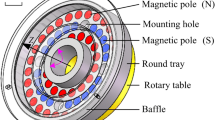Abstract
3-D components used in today’s industries need fine surface characteristics as a functional requirement. Therefore, it is necessary to improve surface characteristics before putting them into useful applications, by achieving superior surface finish very close to dimensional precision. Magnetorheological fluid-based finishing processes are efficient in achieving ultrafine surfaces. This paper aims to explore the key quality performance of the magnetorheological finishing process in achieving nanolevel finish on Ti6Al4V discs. Sequential experimental design through statistical design of experiments was employed and response surface model was developed. Concentration of abrasive particles and wheel speed were considered as independent process parameters for the present study. To have uniform (or minimum variation) surface roughness values on the entire surface, a negative replica of the workpiece has been fabricated as a tool, and magnetic field was used to create magnetorheological effect. Using a template, surface roughness was measured at the same points before and after finishing. Initial Ra value was found to be the critical process parameter for finishing Ti6Al4V workpiece by magnetorheological finishing. % change in Ra is significantly affected by concentration of abrasive particles (≈50%) followed by initial Ra (≈ 38%). Finishing rate is significantly affected by initial Ra (≈61%) followed by concentration of abrasive particles (≈33%). An area roughness of 49 nm was achieved in the present study.
Similar content being viewed by others
References
Bayoumi M, Abdellatif A (1995) Effect of surface finish on fatigue strength. Eng Fract Mech 51:861–870
Jain VK (2008) Abrasive-based nano-finishing techniques: an overview. Mach Sci Technol 12:257–294. https://doi.org/10.1080/10910340802278133
Sidpara A, Jain VK (2012) Nano-level finishing of single crystal silicon blank using magnetorheological finishing process. Tribol Int 47:159–166. https://doi.org/10.1016/j.triboint.2011.10.008
Jain VK (2009) Magnetic field assisted abrasive based micro-/nano-finishing. J Mater Process Technol 209:6022–6038. https://doi.org/10.1016/j.jmatprotec.2009.08.015
Jain VK (2002) Advanced machining processes. Allied Publishers, Delhi
Jain VK, Sidpara A, Sankar MR, Das M (2012) Nano-finishing techniques: a review. Proc Inst Mech Eng Part C-J Mech Eng Sci 226:327–346. https://doi.org/10.1177/0954406211426948
Huang J, Zhang JQ, Liu JN (2005) Effect of magnetic field on properties of MR fluids. Int J Mod Phys B 19:597–601
Harris DC (2011) History of magnetorheological finishing. Wind Dome Technol Mater XII xxxx:80160N–80160N–22. doi: https://doi.org/10.1117/12.882557
Kumar S, Jain VK, Sidpara A (2015) Nanofinishing of freeform surfaces (knee joint implant) by rotational-magnetorheological abrasive flow finishing (R-MRAFF) process. Precis Eng 42:165–178. https://doi.org/10.1016/j.precisioneng.2015.04.014
Sidpara A, Das M, Jain VK (2009) Rheological characterization of magnetorheological finishing fluid. Mater Manuf Process 24:1467–1478. https://doi.org/10.1080/10426910903367410
Sidpara A, Jain VK (2011) Effect of fluid composition on nanofinishing of single-crystal silicon by magnetic field-assisted finishing process. Int J Adv Manuf Technol 55:243–252. https://doi.org/10.1007/s00170-010-3032-5
de Vicente J, Klingenberg DJ, Hidalgo-Alvarez R (2011) Magnetorheological fluids: a review. Soft Matter 7:3701. https://doi.org/10.1039/c0sm01221a
Shorey AB, Jacobs SD, Kordonski WI, Gans RF (2001) Experiments and observations regarding the mechanisms of glass removal in magnetorheological finishing. Appl Opt 40:20–33. https://doi.org/10.1364/AO.40.000020
Phulé PP (2001) Magnetorheological (MR) fluids: principles and applications. Smart Mater Bull:7–10. https://doi.org/10.1016/S1471-3918(01)80040-X
Jacobs SD, Shorey AB (2000) Magnetorheological finishing: new fluids for new materials. Appl Opt 1:142–144
Miao C, Shafrir SN, Lambropoulos JC et al (2009) Shear stress in magnetorheological finishing for glasses. Appl Opt 48:2585–2594. https://doi.org/10.1364/AO.48.002585
Sidpara A, Jain VK (2011) Experimental investigations into forces during magnetorheological fluid based finishing process. Int J Mach Tools Manuf 51:358–362. https://doi.org/10.1016/j.ijmachtools.2010.12.002
Myers RH (2002) DCM (2002) response surface methodology: process and product optimization using designed experiments, 2nd edn. Wiley, New York
Bas D, Boyacı IH (2007) Modeling and optimization I: usability of response surface methodology. J Food Eng 78:836–845. https://doi.org/10.1016/j.jfoodeng.2005.11.024
Gillespie LK (2006) Mass finishing handbook. Industrial Press Inc., U.S., Newyork
Acknowledgements
Authors acknowledge the help of the Manufacturing Science Lab and 4i Lab, IIT Kanpur for providing their facility to fabricate the fixture for the workpiece and other devices. This paper is a revised and expanded version of the paper entitled “Experimental investigations into nano finishing of Ti6Al4V disc” by G. Parameswari, V.K. Jain and J. Ramkumar presented at the 6th International & 27th AIMTDR Conference (2016) held at College of Engineering Pune, India, during 16–18 December 2016.
Author information
Authors and Affiliations
Corresponding author
Rights and permissions
About this article
Cite this article
Parameswari, G., Jain, V.K., Ramkumar, J. et al. Experimental investigations into nanofinishing of Ti6Al4V flat disc using magnetorheological finishing process. Int J Adv Manuf Technol 100, 1055–1065 (2019). https://doi.org/10.1007/s00170-017-1191-3
Received:
Accepted:
Published:
Issue Date:
DOI: https://doi.org/10.1007/s00170-017-1191-3




